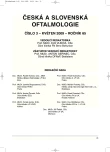Analysis of Prognostic Factors of Anatomical and Functional Results of Idiopathic Macular Hole Surgery
Authors:
R. Kaňovský; T. Jurečka; E. Gelnarová 1
Authors‘ workplace:
Klinika nemocí očních a optometrie a LF Masarykovy univerzity v Brně, přednosta doc. MUDr. S. Synek, CSc.
; Institut biostatistiky a analýz Lékařské a Přírodovědecké fakulty Masarykovy univerzity v Brně, ředitel doc. RNDr. L. Dušek
1
Published in:
Čes. a slov. Oftal., 65, 2009, No. 3, p. 91-96
Overview
Purpose:
Analysis of preoperative prognostic factors in idiopathic macular hole surgery and determination of their significance for the final postoperative visual functions.
Methods:
Ninety-one patients with idiopathic macular hole were enrolled into this study. The best-corrected visual acuity, macular hole staging according to Gass classification and duration of macular hole symptoms were evaluated preoperatively. Pars plana vitrectomy with internal limiting membrane peeling and expanding gas (C3F8) tamponade was subsequently performed in all patients. Macular hole closure rate – anatomical success of the surgery – and visual acuity (functional results) were postoperatively assessed.
Results:
Positive correlation between the duration of the macular hole symptoms and the final postoperative visual functions (Kruskal-Wallis; P=0.003) as well as between the duration of the macular hole symptoms and the postoperative macular hole closure rate (Man-Whitney; P = 0.001) were found in patients with idiopathic macular holes. Postoperative significant improvement of visual acuity depends on the preoperative macular hole stage according to Gass classification (Pearsovov χ2; P = 0.05).
Conclusion:
Macular hole symptoms duration and preoperative macular hole stage are the two significant prognostic factors for postoperative functional and anatomical results.
Key words:
macular hole, pars plana vitrectomy, duration of macular hole symptoms, visual functions
Sources
1. Duker, JS.: Macular Hole. In Yanoff, M., Duker ,JS (Eds): Ophthalmology, second edition, St.Louis, Mosby 2004 s. 942–946
2. Ezra, E., Gregor, ZJ.: Surgery for idiopatic full-thickness macular hole. Two-year results of a randomized trial comparing natural history, vitrectomy, a vitrectomy plus autologous serum: Moorfields macular hole study group report No.1. Arch Ophthalmol, 122, 2004 : 224–236
3. Fišer, I.: Choroby vitreoretinálního rozhraní. In Kuchynka, P. (Ed): Oční lékařství, Praha, Grada 2007, s. 337–345
4. Gass, JD: Reappraisal of biomicroscopic classification of stages of development of a macular hole. Am J Ophthalmol, 119, 1995 : 752–759
5. Ho, AC, Futer, DR, Fine, SL.: Macular hole. Surv Ophthalmol, 42, 1998;5 : 393–416
6. Cheung, CMG, Munshi, V, Mughal, S et al.: Anatomical success rate of macular hole surgery with autologous platelet without internal limiting membrane peeling. Eye, 19, 2005 : 1191–1193
7. Ip, MS., Baker, BJ., Duker, JS. et al.: Anatomical outcomes of surgery for idiopathic macular hole as determined by optical coherence tomography. Arch Ophthalmol, 120, 2002, 1 : 29-35
8. Kalvodová, B., Karel, I., Dotřelová, D. et al.: Operace katarakty u vitrektomovaných očí pro idiopatickou makulární díru. Čes a slov. Oftal., 57, 2001, No.2 : 75–79
9. Karel, I., Kalvodová, B., Dotřelová, D. et al.: Vitrektomie a koncentrát autologních trombocytů v léčbě idiopatických makulárních děr. Čes a slov. Oftal., 55, 1999, No.4 : 191–202
10. Kolář, P., Vlková, E.: Dlouhodobé výsledky chirurgického řešení idiopatické makulární díry s peelingem vnitřní limitující membrány. Čes a slov. Oftal., 62, 2006, No.1 : 34–41
11. Krásnik, V, Strmeň, P., Javorská, L.: Dlhodobé sledovanie zrakových funkcií po anatomicky úspešnej chirurgickej liečbe idiopatickej diery makuly. Čes a slov. Oftal., 57, 2001, No.2 : 80–87
12. La Cour, M., Trios, J.: Macular holes: classification, epidemiology, natural history and treatment. Acta Ophthalmol. Scand 80, 2002 : 579–587
13. Landolfi, M., Zarván, MA, Bhagat, N.: Macular holes. Ophthalmol Clin N Am 15, 2002 : 565–572
14. Tasman, W., Jaeger, EA.: Duane‘s Clinical Ophthalmology on CD-ROM. Philadelphia: Lippincott Williams & Wilkins, 2005
Labels
OphthalmologyArticle was published in
Czech and Slovak Ophthalmology

2009 Issue 3
Most read in this issue
- Examination of the Acute Central Retinal Artery Occlusion (CRAO) by Means of Optical Coherence Tomography (OCT3)
- Changes in the Retinal Nerve Fiber Layer in Non-Arteritic Anterior Ischemic Optic Neuropathy Revealed by Means of the Optical Coherence Tomography
- Awareness and Quality of Life in Patients with Glaucoma
- Analysis of Prognostic Factors of Anatomical and Functional Results of Idiopathic Macular Hole Surgery
